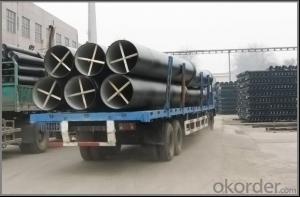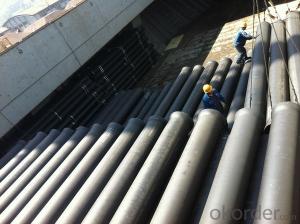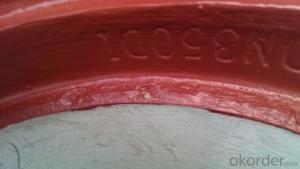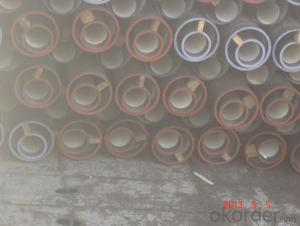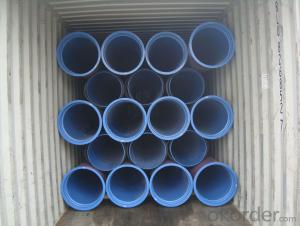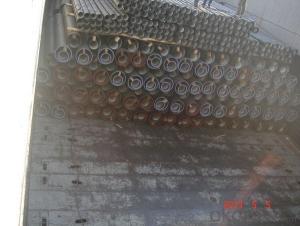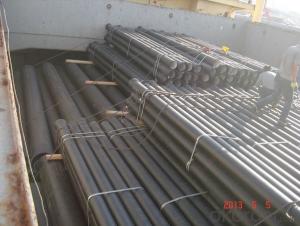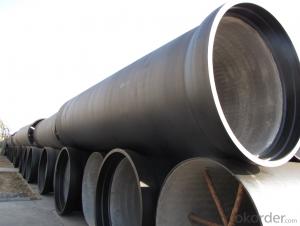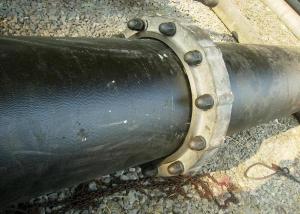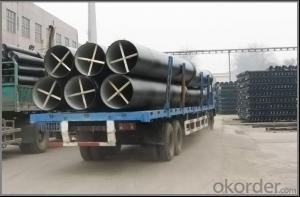T Type Ductile Iron Pipe DN300 Socket spigot pipe
- Loading Port:
- Tianjin
- Payment Terms:
- TT OR LC
- Min Order Qty:
- 25
- Supply Capability:
- 20000 /month
OKorder Service Pledge
OKorder Financial Service
You Might Also Like
1) The standard of pipe: ISO2531:1998, EN545:2006,K9 K8
2) Effective length: 6m/5.7m
3) Inner cement line: Portland cement lineas per ISO4179
4) Zinc coating: at least 130g/m2 as per ISO8179
5) Bitumen painting: at least 70μm as per ISO8179
6)With 102% quantity of NBR, SBR, or EPDM ring asper ISO4633
7) DN80-DN1200
8) Highstrength, lighter than grey iron, good corrosion resistance, no furring, smallflow resistance, easy fixing, long life tome about 100 yeas
9)Checked by automatic inspection equipment
10) Composition:
Chemical composition | |||
Chemical composition | Ductile Cast Iron Pipe (%) | Grey iron pipe (%) | Steel pipe (%) |
C | 3.5-4.0 | 3.2-3.8 | 0.1-0.2 |
Si | 1.9-2.6 | 1.4-2.2 | 0.15-0.4 |
Mn | 0.15-0.45 | 0.4-0.6 | 0.3-0.6 |
P | ≤0.06 | ≤0.3 | 0.02-0.03 |
S | ≤0.02 | ≤0.1 | 0.02-0.03 |
Mg | 0.03-0.06 |
|
|
11) Feature:
Mechanical properties | |||
| Ductile Cast Iron Pipe | Grey Iron Pipe | Steel Pipe |
Tensile Strength(Mpa) | ≥420 | 150-260 | ≥400 |
Yield Strength(Mpa) | ≥300 | No Confirmation | No Confirmation |
Bending Strength(Mpa) | ≥590 | 200-360 | ≥400 |
Elongation (%) | ≥10 | Neglected | ≥18 |
Brinell Hardness(HBS) | ≤230 | ≤230 | About 140 |
12) T type mechanical joint
13) Packing: in bulk or container
PACKING: 1) Pipesare bundled together with the steel belt.
2) Wooden pieces are put between the pipes.
- Q: Can ductile iron pipes be used in high-pressure applications?
- High-pressure applications can indeed utilize ductile iron pipes. These pipes boast impressive strength and durability, which renders them suitable for managing high-pressure fluids or gases. When compared to alternative pipe types like PVC or HDPE, ductile iron pipes possess a higher pressure rating. Moreover, they exhibit excellent resistance to external loads and have the capacity to endure high internal pressures. Water and wastewater systems frequently employ these pipes, alongside industrial settings that encounter high-pressure conditions. Nevertheless, it is crucial to guarantee that ductile iron pipes utilized in high-pressure scenarios adhere to the necessary standards and specifications to assure safe and dependable operation.
- Q: Can ductile iron pipes be used for irrigation of sports fields?
- Indeed, ductile iron pipes are suitable for the irrigation of sports fields. Renowned for their robustness, longevity, and flexibility, these pipes are an excellent choice for a range of applications, including irrigation. With their ability to withstand external pressures and impacts, ductile iron pipes are particularly advantageous for sports fields that encounter heavy foot traffic and potential damage. Moreover, these pipes exhibit exceptional resistance to corrosion, guaranteeing enduring performance and minimal upkeep. The pipes' smooth interior surface also facilitates efficient water flow, preventing obstructions and ensuring adequate irrigation for the sports fields. All in all, ductile iron pipes represent a dependable and appropriate option for irrigation systems in sports fields.
- Q: What is the cost of ductile iron pipes compared to other pipe materials?
- The cost of ductile iron pipes can vary depending on various factors such as size, length, and supplier. However, in general, ductile iron pipes tend to be more expensive compared to other pipe materials such as PVC (polyvinyl chloride) or steel. This is mainly due to the manufacturing process and the inherent qualities of ductile iron that make it a durable and reliable choice for various applications. Ductile iron pipes are known for their high tensile strength, resistance to corrosion, and durability, making them suitable for carrying potable water, wastewater, and other fluids under high pressure. The production process of ductile iron involves adding magnesium to cast iron, which results in improved strength and flexibility. This additional process, along with the quality of the material, contributes to the higher cost. On the other hand, pipes made from materials like PVC or steel can be less expensive. PVC pipes are lightweight, easy to install, and relatively inexpensive, making them a popular choice for low-pressure applications such as irrigation or drainage systems. Steel pipes, known for their strength and durability, are often used in high-pressure applications but come at a higher cost than PVC. Ultimately, the cost of ductile iron pipes may be higher initially, but their longer lifespan and reliability can offset the investment over time. Additionally, factors such as the specific project requirements, local regulations, and availability of materials can also influence the overall cost comparison between ductile iron pipes and other pipe materials.
- Q: Water supply pipe is ductile iron, then it's fittings and valves and other parts must be ductile iron?
- Valve parts and materials do not require the same pipe material, as long as it can meet the use requirements and cost-effective.
- Q: How do ductile iron pipes handle internal scale buildup?
- Ductile iron pipes are highly resistant to internal scale buildup due to their smooth inner surface. The material's inherent strength and durability allow it to withstand the pressure exerted by scale deposits without significant damage or reduced performance. Additionally, the smooth surface of ductile iron pipes minimizes the adhesion of scale, preventing its accumulation and ensuring efficient flow of water or other fluids. Regular maintenance and periodic cleaning can further enhance the longevity and performance of ductile iron pipes in managing any potential scale buildup.
- Q: What are the different types of joints used in ductile iron pipes?
- There are several types of joints commonly used in ductile iron pipes. These joints are designed to provide a secure and leak-proof connection between pipe sections. Here are some of the most commonly used joint types: 1. Push-on joint: This type of joint is easy to install and requires no special tools. It involves lubricating the gasket on one end of the pipe and pushing it into the socket of the adjoining pipe. The gasket creates a tight seal that prevents leakage. 2. Mechanical joint: This joint type consists of a gland and a follower gasket. The gland is placed over the spigot end of one pipe, and the follower gasket is inserted into the bell end of the adjoining pipe. The gland is then tightened with bolts and nuts, compressing the gasket to form a secure joint. 3. Restrained joint: This joint is used in applications where pipes need to be restrained against axial movement or pressure thrust. It typically involves a mechanical joint with additional components such as tie rods, thrust blocks, or restrained couplings to provide the necessary restraint. 4. Flanged joint: Flanged joints are commonly used in large diameter ductile iron pipes. They involve a flange on one pipe end and a mating flange on the other pipe end. The two flanges are bolted together, creating a strong and secure connection. Flanged joints allow for easy disassembly and reassembly if needed. 5. Welded joint: Welded joints are created by fusing the ends of two pipes together using heat and pressure. This type of joint provides a permanent and strong connection. Welded joints are commonly used in underground or buried applications where long-term durability is essential. It is important to note that the choice of joint type depends on factors such as pipe diameter, application, and project requirements. Consulting with a professional engineer or the manufacturer's guidelines is recommended to ensure the appropriate joint type is selected for ductile iron pipes.
- Q: Can ductile iron pipes be used for wastewater reuse projects?
- Yes, ductile iron pipes can be used for wastewater reuse projects. Ductile iron is a strong and durable material that can withstand the corrosive nature of wastewater. It is commonly used in wastewater treatment plants and distribution systems for its ability to handle high-pressure and heavy loads. Additionally, ductile iron pipes have a long lifespan, making them a reliable choice for wastewater reuse projects.
- Q: How much is the installation fee of the 400 largest ductile iron pipe?
- Compared with the PE pipe, from the installation time, ductile pipe PE pipe installation is simple and rapid, and after the installation of internal and external pressure bearing better tightness and corrosion resistance; from the point of view, ductile pipe sealing better after installation, but also can improve the corrosion resistance through various anti-corrosion methods;
- Q: Can ductile iron pipes be used for irrigation pivot systems?
- Indeed, irrigation pivot systems can utilize ductile iron pipes. Renowned for their robustness, longevity, and resistance to corrosion, ductile iron pipes are apt for numerous purposes, including irrigation. These pipes have the capability to withstand substantial water pressure, guaranteeing a dependable and enduring means of transporting water to irrigation pivot systems. Moreover, ductile iron pipes harmonize seamlessly with a variety of fittings and connectors commonly employed in irrigation systems, thereby facilitating effortless installation and upkeep. All in all, employing ductile iron pipes in irrigation pivot systems emerges as a pragmatic decision that ensures efficacious water distribution while minimizing the likelihood of pipe failure.
- Q: Do ductile iron pipes require external protection against stray electrical currents?
- Yes, ductile iron pipes do require external protection against stray electrical currents. This is necessary to prevent corrosion and ensure the longevity of the pipes.
Send your message to us
T Type Ductile Iron Pipe DN300 Socket spigot pipe
- Loading Port:
- Tianjin
- Payment Terms:
- TT OR LC
- Min Order Qty:
- 25
- Supply Capability:
- 20000 /month
OKorder Service Pledge
OKorder Financial Service
Similar products
Hot products
Hot Searches
Related keywords
